中国经济专题【英文精品】
- 格式:ppt
- 大小:1.77 MB
- 文档页数:97
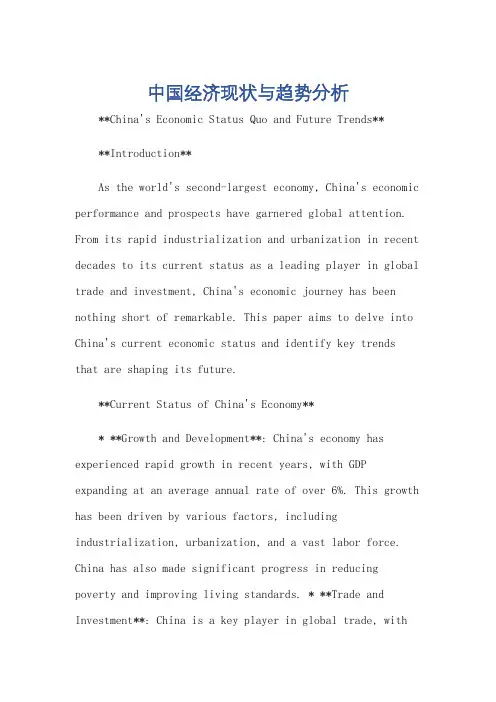
中国经济现状与趋势分析**China's Economic Status Quo and Future Trends****Introduction**As the world's second-largest economy, China's economic performance and prospects have garnered global attention. From its rapid industrialization and urbanization in recent decades to its current status as a leading player in global trade and investment, China's economic journey has been nothing short of remarkable. This paper aims to delve into China's current economic status and identify key trendsthat are shaping its future.**Current Status of China's Economy*** **Growth and Development**: China's economy has experienced rapid growth in recent years, with GDP expanding at an average annual rate of over 6%. This growth has been driven by various factors, including industrialization, urbanization, and a vast labor force. China has also made significant progress in reducing poverty and improving living standards. * **Trade and Investment**: China is a key player in global trade, withits exports and imports accounting for a significantportion of the world's total. The country has also been actively investing in other countries, seeking to expandits economic influence and access new markets. ***Structural Changes**: In recent years, China has been undergoing significant structural changes in its economy. This includes a shift from a reliance on low-cost manufacturing to a more innovation-driven model, as well as a focus on green and sustainable development.**Future Trends Shaping China's Economy*** **Digitalization and Technology**: With the rapid development of digital technology, China is poised to lead the way in digitalization and innovation. The country has already made significant investments in areas such as 5G, artificial intelligence, and blockchain, which are expected to drive future economic growth. * **Consumer-Driven Growth**: As China's middle class continues to expand, consumer demand is expected to drive economic growth. This shift towards a consumer-driven economy will require companies to innovate and adapt to changing consumer preferences. * **Green Development**: With environmentalsustainability becoming a global priority, China is prioritizing green development. This includes investing in renewable energy, promoting eco-friendly production methods, and implementing strict environmental regulations. ***Global Integration**: China is increasingly integrating with the global economy, seeking to expand its influenceand access new markets. This trend is expected to continue, with China playing a key role in global trade and investment.**Conclusion**China's economy has undergone remarkable transformation in recent decades, and the future looks promising. With a focus on digitalization, consumer-driven growth, green development, and global integration, China is poised to continue its economic rise and play a pivotal role in the global economy. However, challenges such as structural imbalances, environmental degradation, and socialinequality need to be addressed to ensure sustainable and inclusive economic growth.**中国经济现状与趋势分析**中国作为世界第二大经济体,其经济绩效和前景一直备受全球关注。
![大学外贸英语chapter 3 China’s Economy[精]](https://uimg.taocdn.com/b450368d6294dd88d0d26bef.webp)
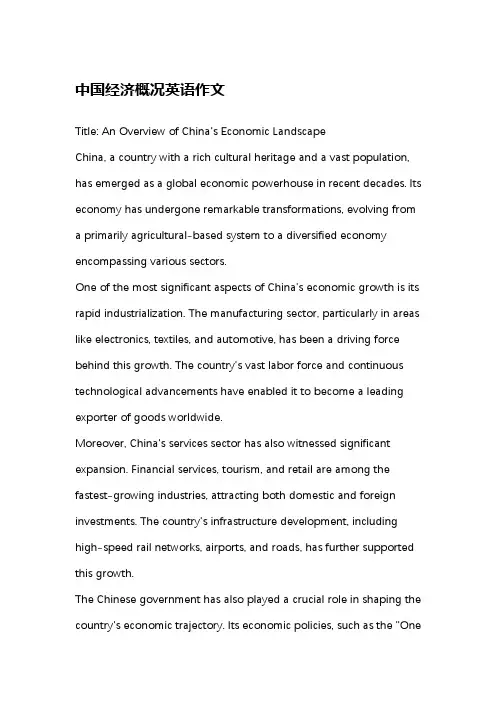
中国经济概况英语作文Title: An Overview of China's Economic LandscapeChina, a country with a rich cultural heritage and a vast population, has emerged as a global economic powerhouse in recent decades. Its economy has undergone remarkable transformations, evolving from a primarily agricultural-based system to a diversified economy encompassing various sectors.One of the most significant aspects of China's economic growth is its rapid industrialization. The manufacturing sector, particularly in areas like electronics, textiles, and automotive, has been a driving force behind this growth. The country's vast labor force and continuous technological advancements have enabled it to become a leading exporter of goods worldwide.Moreover, China's services sector has also witnessed significant expansion. Financial services, tourism, and retail are among the fastest-growing industries, attracting both domestic and foreign investments. The country's infrastructure development, including high-speed rail networks, airports, and roads, has further supported this growth.The Chinese government has also played a crucial role in shaping the country's economic trajectory. Its economic policies, such as the "OneBelt, One Road" initiative, aim to promote regional integration and enhance trade relations with other countries. Additionally, the government's focus on innovation and technology has led to significant investments in research and development, fostering a vibrant startup ecosystem.However, China's economy faces some challenges as well. Issues like environmental pollution, income inequality, and the aging population require urgent attention. The country is also grappling with the complexities of transitioning from an export-oriented economy to one that relies more on domestic consumption.Overall, China's economic progress has been nothing short of remarkable. Its dynamic economy, coupled with its vast potential, makes it a crucial player in the global economic landscape. As the country continues to evolve and adapt to changing global conditions, it remains to be seen how its economy will further shape the world in the coming years.。
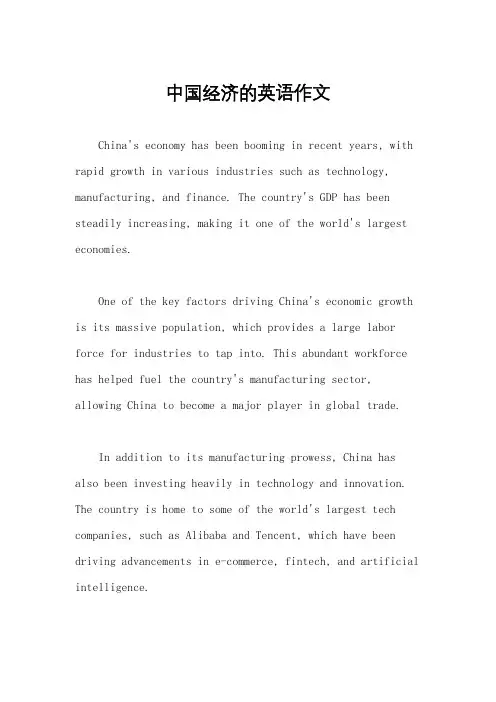
中国经济的英语作文China's economy has been booming in recent years, with rapid growth in various industries such as technology, manufacturing, and finance. The country's GDP has been steadily increasing, making it one of the world's largest economies.One of the key factors driving China's economic growth is its massive population, which provides a large labor force for industries to tap into. This abundant workforce has helped fuel the country's manufacturing sector, allowing China to become a major player in global trade.In addition to its manufacturing prowess, China has also been investing heavily in technology and innovation. The country is home to some of the world's largest tech companies, such as Alibaba and Tencent, which have been driving advancements in e-commerce, fintech, and artificial intelligence.Despite its economic success, China also faces challenges such as income inequality and environmental pollution. The wealth gap between urban and rural areas remains significant, while pollution from factories and vehicles continues to pose a threat to public health.To address these issues, the Chinese government has been implementing various policies to promote sustainable development and reduce poverty. Initiatives such as the Belt and Road Initiative and the Made in China 2025 plan aim to boost infrastructure investment and upgrade the country's manufacturing capabilities.Overall, China's economy continues to show resilience and adaptability in the face of global challenges. With a strong focus on innovation and sustainable growth, the country is poised to maintain its position as a major economic powerhouse in the years to come.。
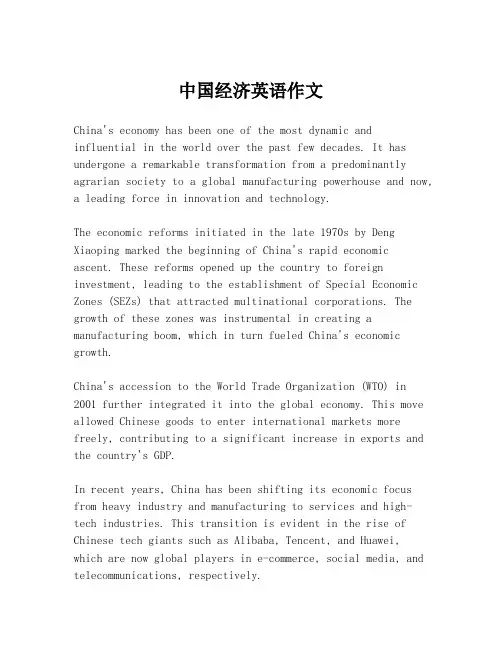
中国经济英语作文China's economy has been one of the most dynamic andinfluential in the world over the past few decades. It has undergone a remarkable transformation from a predominantly agrarian society to a global manufacturing powerhouse and now, a leading force in innovation and technology.The economic reforms initiated in the late 1970s by Deng Xiaoping marked the beginning of China's rapid economic ascent. These reforms opened up the country to foreign investment, leading to the establishment of Special Economic Zones (SEZs) that attracted multinational corporations. The growth of these zones was instrumental in creating a manufacturing boom, which in turn fueled China's economic growth.China's accession to the World Trade Organization (WTO) in 2001 further integrated it into the global economy. This move allowed Chinese goods to enter international markets more freely, contributing to a significant increase in exports and the country's GDP.In recent years, China has been shifting its economic focus from heavy industry and manufacturing to services and high-tech industries. This transition is evident in the rise of Chinese tech giants such as Alibaba, Tencent, and Huawei, which are now global players in e-commerce, social media, and telecommunications, respectively.The Chinese government has also been investing heavily in infrastructure, both domestically and through the Belt and Road Initiative, which aims to enhance connectivity and cooperation between Asia, Europe, and Africa. This initiative is seen as a means to promote trade and economic development in the participating countries.However, China's economic growth has not been without challenges. Issues such as income inequality, environmental degradation, and a rapidly aging population pose significant hurdles for the country's continued prosperity. Moreover, the ongoing trade tensions with the United States have added an element of uncertainty to China's economic outlook.Despite these challenges, China's economy remains robust, with a large domestic market and a strong government commitment to maintaining growth and stability. The country's continued efforts to diversify its economy and embrace innovation are likely to keep it at the forefront of the global economic landscape for years to come.。

中国经济的支柱英文作文英文:China's economy is supported by several key pillars, including manufacturing, agriculture, and technology. The manufacturing sector is a critical component of the Chinese economy, as it accounts for a significant portion of the country's GDP and provides employment for millions of people. China is known as the "world's factory" due to its large-scale production of goods such as electronics, clothing, and machinery.In addition to manufacturing, agriculture also plays a crucial role in China's economy. The country is one of the world's leading producers of rice, wheat, and other crops, and agriculture employs a large portion of the population, particularly in rural areas. The government has implemented various policies and initiatives to support and modernize the agricultural sector, recognizing its importance in ensuring food security and rural development.Furthermore, China has made significant strides in the field of technology, with companies like Huawei, Alibaba, and Tencent leading the way in innovation and digitalization. The technology sector has become a key driver of economic growth, attracting investment and fostering entrepreneurship. China's advancements in areas such as e-commerce, artificial intelligence, and telecommunications have positioned it as a global leader in the digital economy.Overall, these pillars of the Chinese economy work in tandem to support the country's economic development and prosperity. The interplay between manufacturing, agriculture, and technology creates a diverse and resilient economic landscape, enabling China to adapt to changing global trends and challenges.中文:中国经济的支柱包括制造业、农业和科技。

中国经济发展英文作文Economic Development in China 中国的经济发展The economic development of China has been a remarkable journey, transforming the country from a largely agrarian society to one of the world"s largest economies.Over the past few decades, China has undergone rapid industrialization and urbanization, leading to significant economic growth.中国的经济发展是一个显著的历程,将一个主要农业社会转变为世界上最大的经济体之一。
在过去的几十年里,中国经历了快速的工业化和城市化,导致了显著的经济增长。
One of the key factors contributing to China"s economic success has been its focus on exports and investment.The country has become a global leader in manufacturing, exporting a wide range of products to countries around the world.Additionally, China has invested heavily in infrastructure and technology, which has further boosted its economic growth.中国经济发展的重要因素之一是其对出口和投资的关注。
中国已成为全球制造业的领导者,向世界各地的国家出口各种各样的产品。
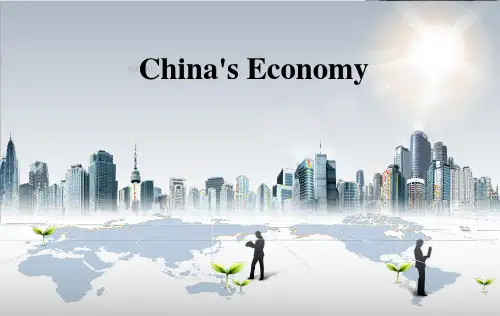
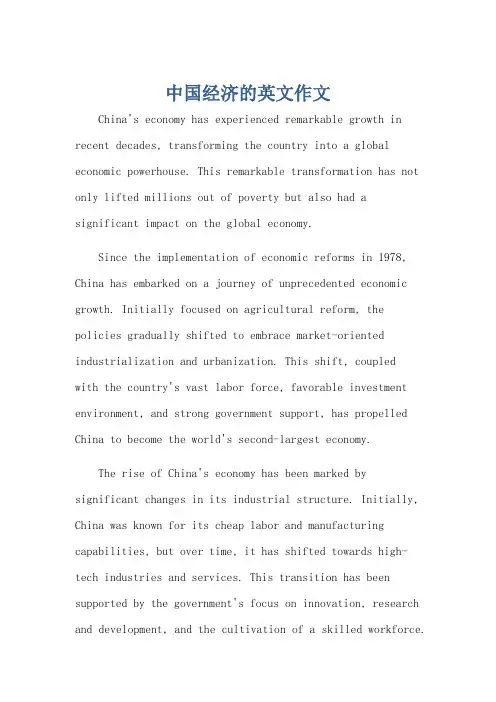
中国经济的英文作文China's economy has experienced remarkable growth in recent decades, transforming the country into a global economic powerhouse. This remarkable transformation has not only lifted millions out of poverty but also had asignificant impact on the global economy.Since the implementation of economic reforms in 1978, China has embarked on a journey of unprecedented economic growth. Initially focused on agricultural reform, the policies gradually shifted to embrace market-oriented industrialization and urbanization. This shift, coupledwith the country's vast labor force, favorable investment environment, and strong government support, has propelled China to become the world's second-largest economy.The rise of China's economy has been marked bysignificant changes in its industrial structure. Initially, China was known for its cheap labor and manufacturing capabilities, but over time, it has shifted towards high-tech industries and services. This transition has been supported by the government's focus on innovation, research and development, and the cultivation of a skilled workforce.Moreover, China's economic growth has been fuelled by its robust trade relationships with other countries. As a leading exporter of goods and services, China has forged strong trade ties with countries across the globe. Its exports range from manufactured goods to technology products, while its imports include raw materials, energy, and consumer goods. This extensive trade network has not only boosted China's economic growth but also contributed to global economic stability.However, the rise of China's economy has not been without challenges. Issues such as environmental degradation, income inequality, and the sustainability of growth have emerged as key concerns. To address these challenges, the Chinese government has implemented a range of policies aimed at promoting sustainable development, reducing inequality, and strengthening environmental protection.Despite these challenges, the rise of China's economy has had a significant impact on the global economy. China's demand for raw materials and energy has driven up prices, while its growing consumer market has created newopportunities for businesses worldwide. Furthermore,China's investment in infrastructure and technology has had a positive spillover effect on other economies, driving growth and innovation.Looking ahead, China's economy continues to show strong growth potential. The country's focus on innovation, technology, and sustainable development is expected to drive further economic expansion. At the same time, China's increasing role in global trade and investment is likely to deepen its economic ties with other countries, further shaping the global economic landscape.In conclusion, the rise of China's economy has been a remarkable phenomenon that has transformed the country and had a significant impact on the global economy. While challenges remain, China's commitment to sustainable development and innovation suggests that its economic rise is likely to continue in the future.**中国经济的崛起与全球影响**近年来,中国经济经历了显著的增长,已经成为全球经济的重要力量。
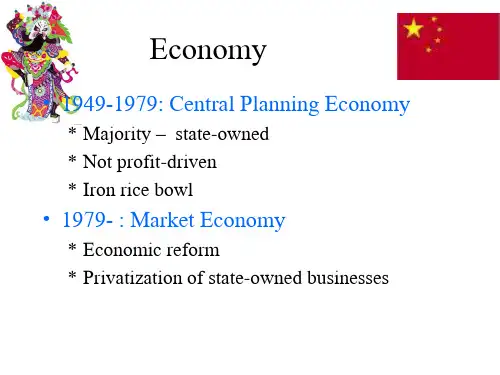

中国经济发展英语China's Economic DevelopmentChina's economic development has been one of the most remarkable success stories of the modern era. Over the past few decades, China has transformed itself from a largely agrarian society into the world's second-largest economy. This rapid economic growth has lifted hundreds of millions of people out of poverty, created a burgeoning middle class, and positioned China as a global economic powerhouse.One of the key drivers of China's economic development has been its focus on export-oriented manufacturing. In the 1980s, Chinese leaders implemented a series of market-oriented reforms, opening up the country to foreign investment and trade. This move allowed China to tap into global markets and take advantage of its abundant labor force. Today, China is often referred to as the "world's factory" due to its role as a major exporter of consumer goods and industrial products.The rise of China's manufacturing sector has been accompanied by significant infrastructure development. China has invested heavily in building roads, bridges, ports, and rail networks, creating an extensive transportation network that facilitates trade both domestically and internationally. This infrastructure development has not only promoted economic growth but has also improved the quality of life for many Chinese citizens.In recent years, China has also made significant strides in technological innovation. The government has placed a strong emphasis on research and development, leading to breakthroughs in areas such as telecommunications, renewable energy, and artificial intelligence. Chinese tech giants like Huawei and Alibaba have become global leaders in their respective industries, putting China at the forefront of the digital transformation.Another important aspect of China's economic development is its expanding domestic market. As incomes rise and a middle class emerges, the demand for consumer goods and services has skyrocketed. This has created numerous business opportunities forboth domestic and international companies. Many multinational corporations now view China as a vital market for their products and services.China's economic development has not been without challenges. Rapid urbanization has resulted in environmental issues, including air and water pollution. The government has recognized these problems and is taking steps to address them through initiatives such as promoting sustainability, investing in renewable energy, and implementing stricter environmental regulations.Furthermore, China's economic growth has also led to concerns about income inequality. While many have benefited from the country's economic boom, there are still significant disparities in wealth distribution. The government has introduced measures to bridge the gap, such as implementing social welfare programs and promoting inclusive growth.Looking ahead, China's economic development is expected to continue at a steady pace. The government has outlined its goals for the future, including transitioning to a more consumption-driven economy, promoting innovation and entrepreneurship, and further opening up its markets to foreign investment. As China continues to play an increasingly influential role on the global stage, its economic development will undoubtedly have far-reaching implications for the world economy.In conclusion, China's economic development has been a remarkable success story, characterized by rapid growth, technological innovation, and infrastructure development. Its transformation from an agrarian economy to a global economic powerhouse has lifted millions out of poverty and created a thriving middle class. While challenges remain, the future looks promising as China continues to prioritize sustainable growth, innovation, and inclusivity.。
China's Remarkable Economic GrowthChina's economic development has been nothing short of astounding, transforming the country from a predominantly agricultural society into a global economic powerhouse. Over the past few decades, China has achieved remarkable growth rates, becoming one of the largest economies in the world. This transformation is a testament to the country's resilience, innovation, and determination to modernize and industrialize.One of the key factors driving China's economic growth has been its commitment to market-oriented reforms. Since the late 1970s, China has gradually opened up its economy to foreign investment and trade, fostering a vibrant business environment that has attracted companies from across the globe. This process of globalization has not only brought capital and technology into the country but has also created millions of jobs and lifted millions out of poverty.Moreover, China's vast population and growing middle class have provided a庞大的市场 for consumer goods and services. This has spurred the development of variousindustries, including manufacturing, construction, and technology. China has become a leading exporter of goods such as electronics, textiles, and toys, while its domestic market has become increasingly lucrative for foreign brands and investors.Another significant aspect of China's economic growthis its commitment to infrastructure development. The country has invested heavily in roads, railways, bridges, airports, and other critical infrastructure, which has facilitated the movement of goods and people across the vast country. This infrastructure development has also created jobs and driven economic growth in rural and underdeveloped areas.However, China's economic growth has not been without challenges. The country faces issues such as environmental degradation, income inequality, and overdependence on exports. To address these challenges, China has embarked on a series of structural reforms, including shifting its focus from investment-driven growth to consumption-led growth and promoting sustainable development.Despite these challenges, China's economic future remains bright. The country continues to invest in research and development, fostering innovation and technological advancements. China is also gradually opening up its financial markets, allowing for greater integration with the global economy.In conclusion, China's economic development is a remarkable success story that has transformed the country and lifted millions out of poverty. Its commitment to market-oriented reforms, vast population, and growing middle class, along with significant investments in infrastructure, have been key drivers of this growth. While challenges remain, China's economic future remains promising, with the potential for continued growth and prosperity.**中国经济的显著增长**中国的经济发展可谓惊人,使中国从一个以农业为主的社会转变为全球经济强国。
中国经济的英语作文The Chinese economy has been a powerhouse of growth over the past few decades, transforming from a primarily agricultural society to a global manufacturing hub and now a leader in technology and innovation.With its vast population and rich natural resources, China has leveraged its strengths to become the world's second-largest economy. The country's rapid development has not only lifted millions out of poverty but also reshaped the global economic landscape.However, the journey has not been without challenges. China's economy has faced environmental concerns, income disparities, and the need to transition from a focus on heavy industry to a more sustainable and balanced growth model.The government's strategic initiatives, such as the Belt and Road Initiative and the Made in China 2025 plan, aim to further integrate China into the global economy and enhance its position in high-tech industries.Innovation is at the heart of China's economic strategy, with investments in research and development driving advancements in fields like artificial intelligence, renewable energy, and biotechnology.Despite the complexities and uncertainties of the globalmarket, China's commitment to reform and opening up continues to fuel its economic vitality, positioning it as a key player in shaping the future of the world economy.。
中国经济英语作文Over the past few decades, China has undergone a remarkable transformation, evolving from a largely agrarian society to a global economic powerhouse. This essay will explore the key factors that have contributed to the economic rise of China, its current economic status, and the challenges it faces on the path to continued growth.Firstly, the economic reforms initiated in the late 1970s by Deng Xiaoping played a pivotal role in setting the stage for China's economic boom. By shifting from a centrally planned economy to a more market-oriented one, China was able to unleash the entrepreneurial spirit of its people and attract foreign investment on a massive scale.Secondly, China's accession to the World Trade Organization (WTO) in 2001 opened up new avenues for international trade. This integration into the global economy allowed China to become the world's manufacturing hub, with its exports growing exponentially and contributing significantly to its GDP.The third factor to consider is the country's massive infrastructure development. The Chinese government has invested heavily in building roads, railways, ports, and airports, which has not only facilitated domestic trade but also made China more accessible to international markets.China's current economic status is that of the world's second-largest economy, with a GDP that has grown at an average annual rate of nearly 10% since the reforms began. This growth has lifted millions out of poverty and created a burgeoning middle class with increasing purchasing power.However, the path to sustained economic growth is not without its challenges. One of the major issues China faces is the need to transition from a manufacturing-based economy to one driven by services and innovation. This requires a shift in educational focus and a strengthening of intellectual property rights to encourage domestic innovation.Additionally, China must address the growing incomeinequality and environmental degradation that have accompanied its rapid industrialization. The government has acknowledged these concerns and has initiated policies to promote greener growth and social welfare programs to reduce disparities.In conclusion, China's economic journey has been nothing short of extraordinary. While it has made significant strides in a relatively short period, it must now navigate the complexities of transitioning to a more balanced and sustainable economic model. The world will be watchingclosely as China continues to shape its economic future and its role in the global economy.。